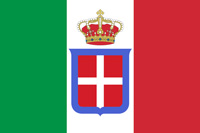World War I (1914-1918)

Battle of Asiago
The Battle of Asiago (Battle of the Plateaux) or the Trentino Offensive (in Italian: Battaglia degli Altipiani), nicknamed Strafexpedition ("Punitive expedition") by the Austrians, was a counteroffensive launched by the Austro-Hungarians on the Italian Front on May 15, 1916, during World War I. It was an unexpected attack that took place near Asiago in the province of Vicenza (now in northeast Italy, then on the Italian side of the border between the Kingdom of Italy The Kingdom of Italy was a state that existed from 1861, when Victor Emmanuel II of Sardinia was proclaimed King of Italy, until 1946. The state resulted from a decades-long process, the Risorgimento, of consolidating the different states of the Italian Peninsula into a single state. That process was influenced by the Savoy-led Kingdom of Sardinia, which can be considered Italy's legal predecessor state. and Austria-Hungary
The Kingdom of Italy was a state that existed from 1861, when Victor Emmanuel II of Sardinia was proclaimed King of Italy, until 1946. The state resulted from a decades-long process, the Risorgimento, of consolidating the different states of the Italian Peninsula into a single state. That process was influenced by the Savoy-led Kingdom of Sardinia, which can be considered Italy's legal predecessor state. and Austria-Hungary Austria-Hungary, often referred to as the Austro-Hungarian Empire, the Dual Monarchy, or Austria, was a constitutional monarchy and great power in Central Europe between 1867 and 1918. Austria-Hungary was one of the Central Powers in World War I, which began with an Austro-Hungarian war declaration on the Kingdom of Serbia on 28 July 1914. ) after the Fifth Battle of the Isonzo (March 1916). Commemorating this battle and the soldiers killed in World War I
Austria-Hungary, often referred to as the Austro-Hungarian Empire, the Dual Monarchy, or Austria, was a constitutional monarchy and great power in Central Europe between 1867 and 1918. Austria-Hungary was one of the Central Powers in World War I, which began with an Austro-Hungarian war declaration on the Kingdom of Serbia on 28 July 1914. ) after the Fifth Battle of the Isonzo (March 1916). Commemorating this battle and the soldiers killed in World War I World War I, also known as the First World War, or the Great War, was a global war originating in Europe that lasted from 28 July 1914 to 11 November 1918. More than 70 million military personnel, including 60 million Europeans, were mobilized in one of the largest wars in history. The war drew in all the world's economic great powers, assembled in two opposing alliances: the Allies versus the Central Powers of Germany and Austria-Hungary. View World War I » is the Asiago War Memorial.
World War I, also known as the First World War, or the Great War, was a global war originating in Europe that lasted from 28 July 1914 to 11 November 1918. More than 70 million military personnel, including 60 million Europeans, were mobilized in one of the largest wars in history. The war drew in all the world's economic great powers, assembled in two opposing alliances: the Allies versus the Central Powers of Germany and Austria-Hungary. View World War I » is the Asiago War Memorial.
Background
Already for some time the Austrian commander-in-chief, General Conrad von Hötzendorf, had been proposing the idea of a Strafexpedition that would lethally cripple Italy, Austria-Hungary's ex-ally, claimed to be guilty of betraying the Triple Alliance, and in previous years he had had the frontier studied in order to formulate studies with regard to a possible invasion.
The problem had appeared to be serious, mostly because the frontier ran through high mountains and the limited Italian advances of 1915 had worsened the situation and excluded a great advance beyond the valleys of Valsugana and Val Lagarina (both connected by railway) and the plateaus of Lavarone, Folgaria and Asiago.
The geographic location of the routes of advance was conducive to the original plan which called for an advance from Trent to Venice, isolating the Italian 2nd and 3rd Armies who were fighting on the Isonzo and the Italian 4th Army who was defending the Belluno region and the eastern Trentino.
The preparations for the battle began in December 1915, when Conrad von Hötzendorf proposed to his German opposite number, General Erich von Falkenhayn, shifting divisions from the Eastern Front in Galicia to the Tyrol, substituting them with German divisions. His request was denied because Germany The German Empire, also referred to as Imperial Germany, the Second Reich, as well as simply Germany, was the period of the German Reich from the unification of Germany in 1871 until the November Revolution in 1918, when the German Reich changed its form of government from a monarchy to a republic. During its 47 years of existence, the German Empire became the industrial, technological, and scientific giant of Europe. was not yet at war with Italy (which would declare war on Germany three months later), and because redeploying German units on the Italian Front would have diminished German offensive capability against Russia
The German Empire, also referred to as Imperial Germany, the Second Reich, as well as simply Germany, was the period of the German Reich from the unification of Germany in 1871 until the November Revolution in 1918, when the German Reich changed its form of government from a monarchy to a republic. During its 47 years of existence, the German Empire became the industrial, technological, and scientific giant of Europe. was not yet at war with Italy (which would declare war on Germany three months later), and because redeploying German units on the Italian Front would have diminished German offensive capability against Russia Russian Empire was an empire and the final period of the Russian monarchy from 1721 to 1917, ruling across large parts of Eurasia. The rise of the Russian Empire coincided with the decline of neighbouring rival powers: the Swedish Empire, the Polish–Lithuanian Commonwealth, Qajar Iran, the Ottoman Empire, and Qing China. Russia remains the third-largest empire in history, surpassed only by the British Empire and the Mongol Empire.. After having received a negative reply from the Germans, who refused the proposed replacement and actively tried to discourage the Austro-Hungarian proposed attack, Conrad von Hötzendorf decided to operate autonomously. The 11th Austro-Hungarian Army, under the command of Count Viktor Dankl, would carry out the offensive followed by the 3rd Army under Hermann Kövess. It was not so easy, however, because the Italians had deployed in the area about 250,000 troops (General Brusati's First Army and part of the Fourth Army). Italian intelligence had been gathering information about an impending enemy offensive in Trentino — and a big one — for about a month, but Cadorna dismissed those reports, persuaded as he was that nothing could happen in that region.
Russian Empire was an empire and the final period of the Russian monarchy from 1721 to 1917, ruling across large parts of Eurasia. The rise of the Russian Empire coincided with the decline of neighbouring rival powers: the Swedish Empire, the Polish–Lithuanian Commonwealth, Qajar Iran, the Ottoman Empire, and Qing China. Russia remains the third-largest empire in history, surpassed only by the British Empire and the Mongol Empire.. After having received a negative reply from the Germans, who refused the proposed replacement and actively tried to discourage the Austro-Hungarian proposed attack, Conrad von Hötzendorf decided to operate autonomously. The 11th Austro-Hungarian Army, under the command of Count Viktor Dankl, would carry out the offensive followed by the 3rd Army under Hermann Kövess. It was not so easy, however, because the Italians had deployed in the area about 250,000 troops (General Brusati's First Army and part of the Fourth Army). Italian intelligence had been gathering information about an impending enemy offensive in Trentino — and a big one — for about a month, but Cadorna dismissed those reports, persuaded as he was that nothing could happen in that region.
Battle
On May 15, 1916, 2,000 Austrian artillery guns opened a heavy barrage against the Italian lines, setting Trentino afire. The Austrian infantry attacked along a 50 km front. The Italian wings stood their ground, but the center yielded, and the Austrians broke through, reaching the beginning of the Venetian plain. With Vicenza about 30 km away, all the Italian forces on the Isonzo faced outflanking.
Cadorna hastily sent reinforcements to the First Army, and deployed the newly formed Fifth Army under Pietro Frugoni to engage the enemy in case they succeeded in entering the plain. The situation was critical.
However, on June 4, the Russians unexpectedly took the initiative in Galicia, where they managed to enter Austrian soil. Although they were effectively countered by German and Austro-Hungarian troops, Hötzendorf was forced quickly to withdraw half of his divisions from Trentino. With that, the Strafexpedition could no longer be sustained and the Austrians retired from many of their positions. Italian troops in the region were increased to 400,000 to counter the Austrian positions.
Although the Strafexpedition had been checked, it had political consequences in Italy: the Salandra Cabinet fell, and Paolo Boselli became the new Prime Minister.
HISTORY

RESOURCES
This article uses material from the Wikipedia articles "World War", "World War I", and "Battle of Asiago", which is released under the Creative Commons Attribution-Share-Alike License 3.0.
© Stories Preschool. All Rights Reserved.









